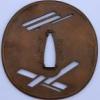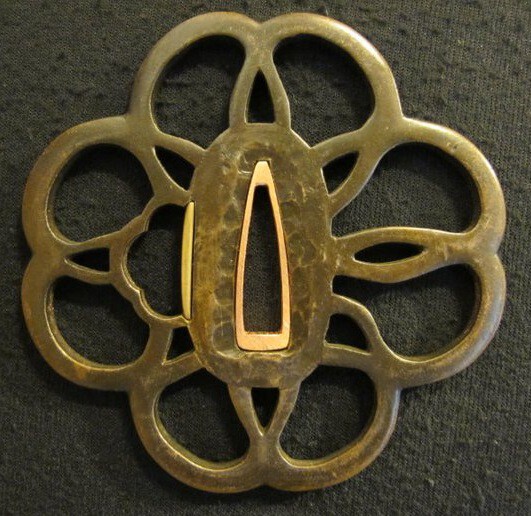-
Posts
870 -
Joined
-
Last visited
-
Days Won
2
Content Type
Profiles
Forums
Events
Store
Downloads
Gallery
Everything posted by Lee Bray
-

"Marijuana leaf motif tsuba"
Lee Bray replied to PietroParis's topic in Auctions and Online Sales or Sellers
Nobody else seeing this? Feel free to delete my comment along with the link. -
This sekigane and the copper insert on the kogai-hitsu-ana were made and installed by me about 15 years ago so please don't think it's an antique addition.(Not directed at you, Dale, just in general.) I was selling the piece and the buyer wanted to install it on a sword he had so I added it so it would be closer to the dimension of his nakago. I figured it was a better way to do it than the buyer using a punch on the actual tsuba.
-

Refinishing a Shirasaya after addition of Sayagaki
Lee Bray replied to Lewis B's topic in General Nihonto Related Discussion
It's likely a wax of some form. Ibota wax is sometimes used in Japan to finish shirasaya. It allows the wood to 'breathe' yet gives a mild sheen to it. -
Just enough to be slightly dangerous, as the saying goes. Grey Doffin wood be the chap to talk to. The chisels you have there are beveled edge wood chisels. The hollow grinds on the back are to make it easier to flatten, and keep flat, the back of the chisel.
-
Size and weight seem off for a regular katana tsuba. It's about twice the weight, 3-4cm too large and 2mm too thick for the 'dancing crane' tsuba one normally sees. Dale is probably on the money with some kind of display piece rather than a real tsuba.
-
The Umetada school used copper/alloy ground with shakudo inlays commonly, Umetada Myoju being well known for it, and I reckon this is trying to emulate that style. Unfortunately, it doesn't do it very well and I wonder if it's a much later copy/utsushi with some heavy duty 'aging' by an amateur. This link shows a good example. http://nihontocraft.com/Umetada_Tsuba.htm
-

We have to talk about chatgpt
Lee Bray replied to Cola's topic in General Nihonto Related Discussion
Rather large, Bazza. Knew it was big but just googled and they reckon it uses the same amount of power as Sweden currently and will rise to Germany's supply by 2026, roughly 500 terawatt hours rising to 1000 terawatt hours. That's AI alone, no internet. -

Wakizashi sales help
Lee Bray replied to Mark Ackerson's topic in General Nihonto Related Discussion
My parents flew out of the UK a few years back with two axes and a tachi for me. Checked in, obviously. I was worried but apparently they had no problems whatsover. -

We have to talk about chatgpt
Lee Bray replied to Cola's topic in General Nihonto Related Discussion
I don't know, it wasn't mentioned, but the post was dated 24th May, 2023, if that helps. Page 10 on this thread. -

We have to talk about chatgpt
Lee Bray replied to Cola's topic in General Nihonto Related Discussion
This came up in the cast tsuba thread by 'Dan Tsuba' a while ago. I forget the exact question but the AI fabricated several books and articles for its answer. So no, I don't think it's close to reliable yet. If it learns from the internet, will it ever be? -
Since the info can be obtained by a simple search of the posted image, it is Shawn Ryan of the podcast "The Shawn Ryan show" and the sword was supposedly given to him by Don Graves, a 98 year old vet who fought on Iwo Jima. Shawn claims the sword came from a Japanese soldier.
-
53.
-
Mokume hada and gunome /midare hamon, koshi-zori would go along with Bizen, as Jean notes for the solitary kanji. Likely Koto. Kissaki appears somewhat extended. What's the distance between the ana on the nakago-jiri and the new nakago-ana? Add that to the nagasa(57cm?) and it should give you a rough indication as to the original length, providing the 'Bi' kanji isn't part of an old gimei.
-
Exagerated sori, crudely shaped nakago, faked patina(imo) on the nakago, strange kanji(if they are kanji at all), plywood...all suggest this is a fake sword.
-
Ed Marshall of Yakiba.com is in Louisiana, if that is not too far.
-
My father bought what he thought was a WW2 sword from a store in Ireland back in the early 70's. He gave it to me 13 years ago and I was happy to see what I believed to be a Nambokucho tachi but the condition was too poor to judge further. Happiness was short lived as I found a large hagire. Turns out that he used it for a short period to chop firewood...hit a knot in the wood, straightened out the sori and thought a reverse strike on the mune would fix the problem. Sori came back but probably caused the hagire. But it seemed to be a good sword so I dragged it across to Japan when I was going to the DTI and had Ikeda-san polish a window in it. He confirmed the Nambokucho call and thought Aoe based on the window and wanted to polish it completely but my funds wouldn't allow that. He also found a second hagire... So if the sword had been papered when my dad bought it, that would answer your question. Here's the sword -
-
The kissaki suggests it is a real Nihonto but I think you'll get no more info on school or period from these photos. The handle is knot Japanese(lol , sorry).
-
Unlikely to be Hanwei as they tend to sign every sword with a lenghty 'Paul Chen/Hanwei, Dalien Province, etc' mei and have an angular kurijiri. Though of course, that could be altered to look more Nihonto like. Carlos, oil and water can be used to create hamon on homogenous steel or folded steel. To qualify as a traditional blade, water is used with folded steel.
-

Ban on carrying swords with Parcelforce
Lee Bray replied to Mick taylor's topic in General Nihonto Related Discussion
-
A couple of my favourites. Both made by Ford Hallam 15 years ago, they were studies in the copper alloy he used to create the Umetada utsushi as shown in Bob Morrison's thread - A series of fittings(or how not to build a collection).
-
Appears to have no seppa so the fitting and originality of the tsuka has to be questioned. Aside from that, nowt much else to see but can't really go wrong for 100 euros.
-
Roger's response is at the top of this page.
-
I have a papered Sue-Mihara wakizashi and it is, frankly put, very boring. Hada is bland and the hamon is lifeless. Absolutely no activity in it whatsoever. Far, far removed from the Ko-Mihara pieces one sees. You could do much better for that money.
-
From what I can see, probably home restoration again, although reasonably well done. I'd imagine katate-maki is slightly easier to do and look good just because there are less diamonds.








